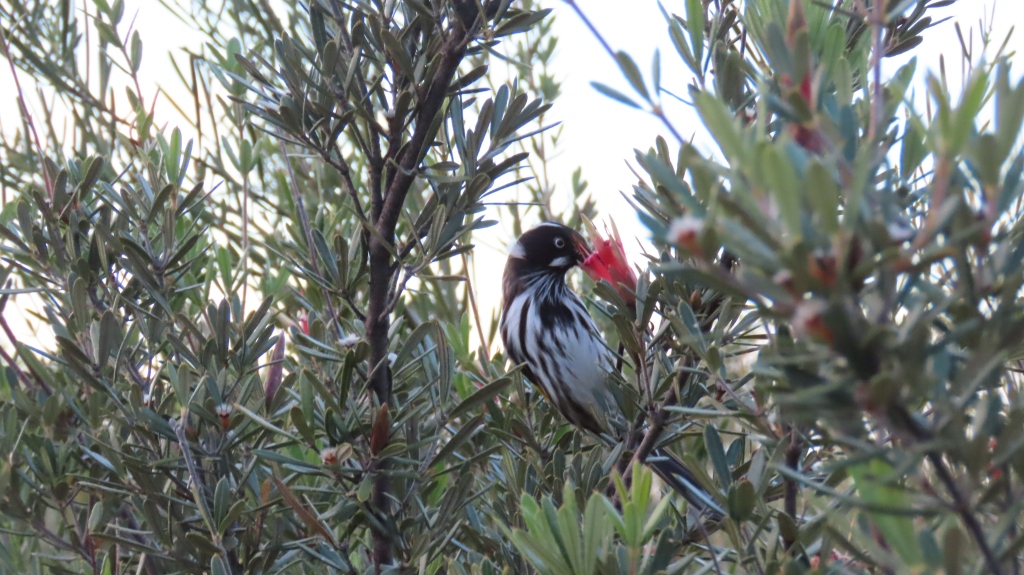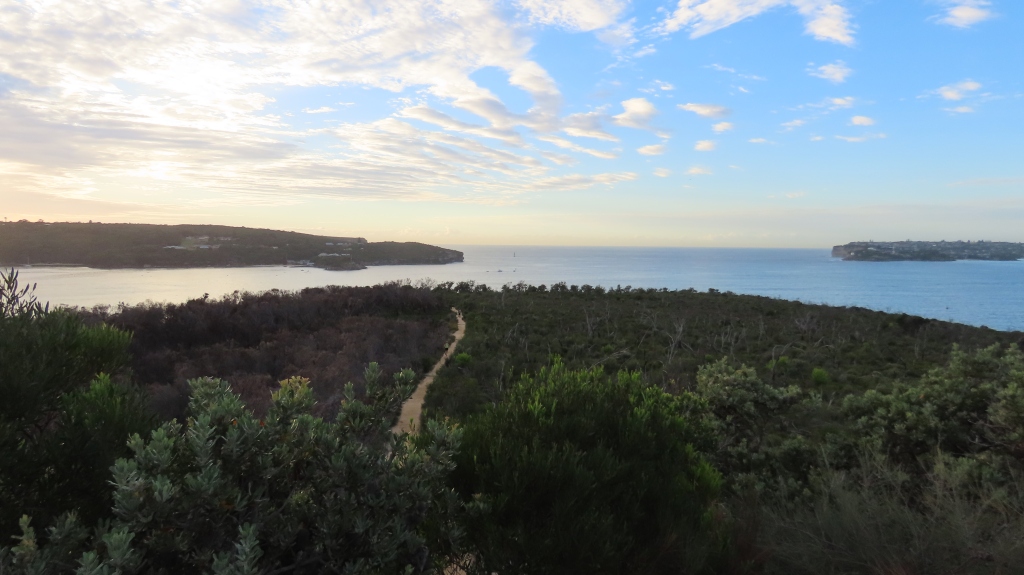Blog Archives
New Holland Honeyeater drinking from Mountain Devil flower
New Holland Honeyeaters are small birds that feed on nectar from flowers, as well as small insects. This video shows one of them drinking from the red, cup-shaped flower of a Mountain Devil bush (Lambertia formosa).
New Holland Honeyeaters are just one of the many types of birds labelled honeyeaters in Australia. It’s a varied and raucous group!
I did take a still photo of the bird, but it’s a bit fuzzy due to the early morning dimness:

After watching the bird a while, I walked further along the path and took a photo looking back the way I’d come. The bird was at the very end of the path in this picture, near the water. In the distance are the two headlands that form the mouth of Sydney Harbour:

Common name: New Holland Honeyeater
Scientific name: Phylidonyris novaehollandiae
Approximate length: 17-19 cm
Date spotted: 23 March 2024 (summer)
Location: Dobroyd Head, New South Wales, Australia: 33°48’38.0″S 151°16’24.3″E
A honeyeater and a view from Dobroyd Head
Dobroyd Head is one of the headlands that juts out into Sydney Harbour, on Australia’s east coast. The walking track leading around Dobroyd Head is part of the Manly to Spit Bridge Trail. It offers plenty of bird life and gorgeous views.
When taking this picture, I was at Fairlight Lookout on Dobroyd Head, looking north east across the harbour towards Manly. On the other side of Manly is the Pacific Ocean. Next stop Fiji and then the United States.

This pretty little bird is a New Holland Honeyeater, its white ear patch tousled by the breeze:

Common name: New Holland Honeyeater
Scientific name: Phylidonyris novaehollandiae
Approximate length: 17-19 cm
Date spotted: 28 August 2021 (winter)
Location: Dobroyd Head, New South Wales, Australia: 33°48’34.7″S 151°16’18.2″E
White-cheeked Honeyeaters and New Holland Honeyeaters hanging out together
Until today, I didn’t realise that we have two very similar types of honeyeaters in the area. I’ve seen and photographed New Holland Honeyeaters before. Yesterday, I took some photos of a number of birds, thinking they were all the same type.
Looking at the photos today, I noticed that some birds in the group have black eyes, some white, and the black-eyed birds seem shorter and more compact than the others. It turns out that the group included White-cheeked Honeyeaters, which I haven’t knowing seen before. They’ve probably been around all along, but I just didn’t notice.
This is a New Holland Honeyeater. Notice the white eye, and the smallish white patch near the beak:
Another New Holland Honeyeater:
Whereas the next one is a White-cheeked Honeyeater. Notice the black eye and the large white patch on the cheek:
This video shows a couple of White-cheeked Honeyeaters. You can hear the calls of the other birds around them:
While I was watching the group of birds, they would all hang out together in their chosen area of bushy cover, then emerge to go foraging in the nearby trees. Every now and then, something would alarm them, and they’d all dive for cover again. Standing near them was a little alarming, as they move extremely fast and I could hear them hitting the leaves all around. After a few moments, they’d emerge and repeat the pattern. The next video shows one such episode:
Common name: White-cheeked Honeyeaters and New Holland Honeyeaters
Scientific name: Phylidonyris nigra and Phylidonyris novaehollandiae
Approximate length: 16-19 cm and 17-19 cm
Date spotted: 9 November 2019 (spring)
Location: Manly Dam Reserve, New South Wales, Australia: 33°46’55.8″S 151°15’26.2″E
New Holland Honeyeater enjoying a foretaste of spring
New Holland Honeyeaters are attractive in their neat black and white stripes, with yellow flares on their wings and tail feathers. This one darts from flower to flower, enjoying a foretaste of spring in the closing weeks of winter.
Common name: New Holland Honeyeater
Scientific name: Phylidonyris novaehollandiae
Approximate length: 17-19 cm
Date spotted: 22 August 2016
Season: Late winter
Location: Manly Dam Reserve, New South Wales, Australia
Approximate latitude/longitude: -33.772336, 151.249022
New Holland Honeyeater at Wineglass Bay Lookout
Not in Sydney this time, I was at Wineglass Bay Lookout in Tasmania when I saw a bush full of New Holland Honeyeaters. This video focuses on one of them, then draws back to show the gorgeous location it’s chosen for its foraging.
Here’s a still picture. Click on it to open it in a new window where you can zoom into the detail.
Common name: New Holland Honeyeater
Scientific name: Phylidonyris novaehollandiae
Approximate length: 17-19 cm
Date spotted: Sunday 9 November 2014
Season: Spring
Location: Wineglass Bay Lookout, Tasmania
Approximate latitude/longitude: 42°08’60.0″S 148°17’20.2″E
New Holland Honeyeater at Manly Dam
This pretty little bird is a New Holland Honeyeater, chirping happily amongst the spring flowers at Manly Dam Reserve.
Common name: New Holland Honeyeater
Scientific name: Phylidonyris novaehollandiae
Approximate length: 17-19 cm
Date spotted: Sunday 6 October 2013
Season: Spring
Location: Manly Dam Reserve, New South Wales, Australia
Approximate latitude/longitude: -33.77294,151.249416





